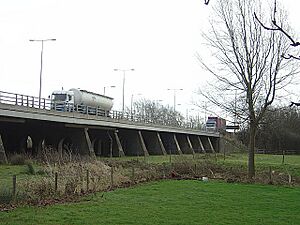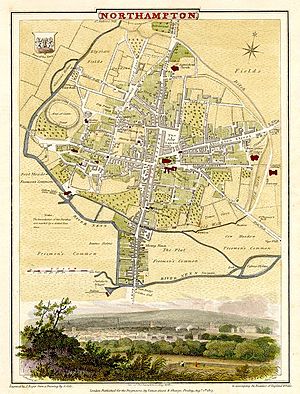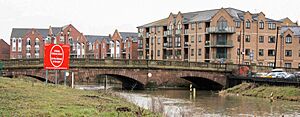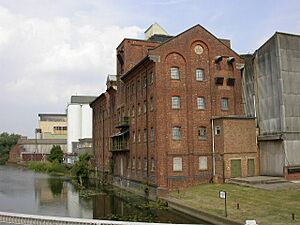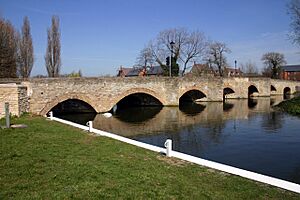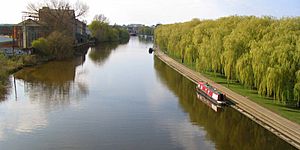River Nene facts for kids
Quick facts for kids River Nene |
|
|---|---|

The River Nene at Kislingbury Watermill, Northamptonshire
|
|
| Country | United Kingdom |
| Constituent country | England |
| Region | Counties: Northamptonshire, Cambridgeshire, Lincolnshire, and Norfolk |
| Physical characteristics | |
| Main source | Arbury Hill Badby, Northamptonshire 155 m (509 ft) 52°13′55″N 1°12′38″W / 52.2319°N 1.2105°W |
| River mouth | The Wash, Lincolnshire 0 m (0 ft) 52°51′09″N 0°13′34″E / 52.8524°N 0.2260°E |
| Length | 100 mi (160 km) |
| Basin features | |
| Basin size | 631 sq mi (1,630 km2) |
The River Nene is a famous river in the east of England. It starts from three small streams in Northamptonshire. The river is about 160 kilometers (100 miles) long. About 6 kilometers (3.7 miles) of it forms the border between Cambridgeshire and Norfolk. It is the tenth-longest river in the United Kingdom. You can travel by boat on the Nene for about 142 kilometers (88 miles), from Northampton all the way to The Wash.
Contents
About the River Nene
The name of the River Nene is very old. No one knows exactly where it came from. Some people think it might be linked to old words for snow, rain, or washing. But this is just a guess. The name was used even before English was spoken in the area.
How to Say "Nene"
People say the river's name differently depending on where they live. In Northamptonshire, it's usually pronounced "Nen". Around Peterborough, it's often pronounced "Neen". The way people say it has changed over time. The name has also been spelled differently, like "Nenn" or "Nyn" in the past.
River Nene's Journey
The River Nene is the tenth-longest river in the United Kingdom. It starts at Arbury Hill. From there to Northampton, the river drops about 91 meters (300 feet) over 27 kilometers (17 miles). For the rest of its journey, it drops less than 61 meters (200 feet). The river collects water from an area of about 1,634 square kilometers (631 square miles). It flows with an average of 9.3 cubic meters (328 cubic feet) of water per second.
Where the Nene Begins
The main source of the river is near Badby village, close to Daventry. Three small streams come together at Dodford mill. These streams flow through villages like Badby, Newnham, and Everdon. From Dodford, the river flows through Weedon. Here, it goes under a railway line, a canal, and an old Roman road called Watling Street. Another stream from Yelvertoft joins the Nene near Weedon. The river then heads towards Northampton, passing through places like Flore and Nether Heyford.
Through Northampton
Near Kislingbury, another stream joins the Nene from the south. The river then flows close to the Grand Union Canal. At Upton Mill, a stream called Wootton Brook adds more water. The River Nene then reaches Northampton. It flows between areas like St. James, Cotton End, and Far Cotton.
The third main source of the Nene, called the Naseby Source, joins the river near the Carlsberg Brewery. This stream flows through the north of Northampton. Several smaller streams join it, some of which fill reservoirs like Pitsford Water. In Northampton, the Nene flows under South Bridge and past Beckett's Park. The Northampton Sea Cadets use the river for boating lessons. A bit further downstream, some of the river's water can be sent to the Nene Whitewater Centre for watersports.
The Nene Valley
After Northampton, the river flows through a wide valley. This valley was formed by melting ice during the Ice Age. The Nene now winds through this flat valley. You can see flood plains, lakes, and old gravel pits along its banks. These gravel pits are now popular for fishing and watersports. Billing Aquadrome at Great Billing is a large park built around the river and these lakes.
At Cogenhoe, the river passes an old watermill. This mill used to grind wheat into flour. Further on, at Earls Barton, there are more lakes and river locks. The river also passes Doddington Lock No 11 and the Hardwater Watermill. This watermill is very old, mentioned in the Domesday Book. It ground flour for almost 1,000 years. Thomas Becket, a famous Archbishop, even hid there once.
Wellingborough and Beyond
The river then turns northeast, flowing past Wellingborough town. Here, it passes Victoria Mills, which still make flour today. In the past, boats used the river to bring goods to and from the mills. The River Ise joins the Nene from the north. On the other side, you can see the remains of the Roman town of Irchester. The river then goes under a large bridge that carries the Midland Main Line railway.
The Nene flows past Irthlingborough and under an old railway bridge. The river then makes big curves as it passes villages like Little Addington, Great Addington, Woodford, and Denford.
Towards Thrapston
At Denford, the river splits into two channels. One of these is used by boats. The channels flow towards Thrapston, going under two bridges. One bridge carries the busy A14 road, and the other is for an old railway line. Between Thrapston and Islip, a low bridge with nine arches crosses the Nene.
North of Thrapston, the river is part of the Titchmarsh Nature Reserve. This reserve has lakes, woodlands, and ponds, and is a great place for wildlife. Another stream, called Harpers Brook, joins the Nene from the northwest. The river then flows south of Oundle, passing Barnwell Country Park and Oundle Marina. The Romans built a bridge over the river here in the first century. Between Oundle and Peterborough, boats pass through 11 locks.
Reaching Peterborough
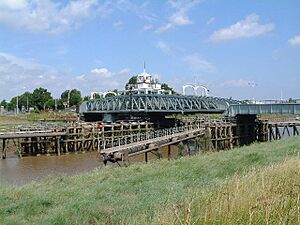
After flowing through the hills of Northamptonshire, the river enters the City of Peterborough. It passes the Nene Valley Railway and the Nene Valley Country Park. Near the city center, there's Woodston Wharf, which used to be where the river became tidal. East of Peterborough, a branch of the river goes under an old railway line. This branch connects to the Middle Levels, which are part of the drainage system of The Fens. From here, boats can reach the River Great Ouse. Below Peterborough, the river forms the border between Cambridgeshire and Norfolk for about 6 kilometers (3.7 miles).
Further downstream, you'll see the 'Embankment' area. After the cathedral city, the river flows through Whittlesey. The landscape then changes to the Nene Washes in The Fens, which are very flat and wide. The river goes under the A47 bridge at Guyhirn, then through the port of Wisbech, and Sutton Bridge in Lincolnshire. Finally, it flows into The Wash between two towers called "the lighthouses".
The Nene connects the Grand Union Canal to the River Great Ouse. Much of its path has been made wider, like a canal, with locks along the way. Some parts are called the "Nene Navigation".
You can travel by boat on the Nene from just above Northampton to the sea. Most people use it for fun between Northampton and Peterborough. Here, it connects to the Middle Level Navigations, which lead to the River Great Ouse. There isn't much commercial shipping on the river anymore, except near the Port of Wisbech.
How Locks Work
The river has many locks that help boats move up and down. These locks can hold boats up to 23.8 meters (78 feet) long and 4 meters (13 feet) wide. Most locks have two types of gates: regular gates at the top and a single gate that lifts up and down at the bottom. When there's a flood, these lifting gates can be raised to let water flow straight through, which helps prevent flooding. But this means boats can't use the river during floods.
In the past, people had to turn a big wheel many times to open or close the lifting gates. Now, the Environment Agency, which manages the river, is adding electric controls to make it easier.
Flooding and Protection
The River Nene has flooded several times, causing problems for nearby towns.
1978 Floods
In January 1978, a big storm caused high tides and flooding along the coast. The water levels were even higher than in the terrible North Sea flood of 1953. Both sides of the river at Wisbech were flooded. A woman drowned in her home, and many people had to leave their houses.
1998 Easter Floods
In April 1998, heavy rain caused widespread flooding in the English Midlands. On Good Friday, the floods were at their worst. The Nene overflowed its banks, flooding parts of Northampton, Wellingborough, and Earls Barton. Areas of Northampton like Cotton End and Far Cotton, which are on the flood plain, were badly hit.
After these floods, a warning system was put in place in Northampton in 2002. Embankments and flood walls were also made stronger to protect the town. In Kislingbury, a project to reduce flooding was finished in 2004. In 2007, the British Government spent £6 million on new flood defenses near Upton Mill in Northampton. They built wetland areas and stronger banks along the river.
2013 Flood
In December 2013, a £12 million project built in 2010 helped protect over 10,000 homes and 1,200 businesses from a major flood. The water came very close to the top of the flood walls in Wisbech, but the new defenses held, preventing serious damage.
River Nene's Namesakes
The River Nene has given its name to a few things:
- A boat called Nene from Wisbech.
- A former football team, Wisbech Nene Rovers.
- The old Nene College of Higher Education in Northampton, which is now the University of Northampton.
- The Nene derby, a local sports rivalry.
- The Rolls-Royce Nene turbojet engine. Rolls-Royce names its jet engines after British rivers. This might be because Sir Henry Royce, one of the company's founders, was born in Alwalton, a village by the river near Peterborough.
See also
 In Spanish: Río Nene para niños
In Spanish: Río Nene para niños


